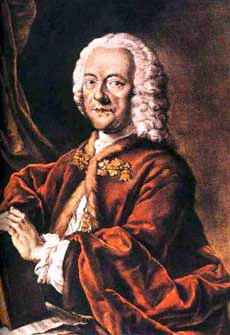Bach composed his Cantata No. 156 in 1729, and Arioso is the first movement found in this cantata. The term cantata means "to be sung," and the musical form of a cantata may be described as a sacred or secular vocal work with instrumental accompaniment. Cantatas are often divided into sections such as choruses, solos, recitatives and arias. During the Baroque era, Bach was a prolific composer of cantatas, and he composed many of them for church services (approximately 200 of his church cantatas are extant). Bach’s first movement of Cantata No. 156 is an instrumental sinfonia, a form which Bach often used as a single-movement instrumental prelude or introductory movement to other pieces in a musical work (sinfonia later came to mean a light version of a symphony). The songlike character of this first movement has contributed to instrumental transcriptions of this movement often being titled arioso, a term which means "like an aria" or melodious. [24]
During the Baroque period, it was a common practice for musicians to reuse and rework some of their melodies in other pieces (Handel and Vivaldi were particularly well-known for this practice). Some scholars have proposed that Bach first used Arioso’s melody in a now lost D minor oboe concerto. After using a version of the same melody in his Cantata No. 156, Bach apparently reused the melody for the second movement of his harpsichord Sonata in F minor.

Some scholars have also found similarities between Bach’s Arioso melody and a piece written by another prominent German musician, Georg Philipp Telemann. These scholars have speculated that Bach modeled his melody after the first movement of Telemann’s G-major concerto for solo oboe or flute and strings (TWV 51:G2). They described this process as: "Bach used transformative imitation to turn preexistent music by another composer into a distinctive expression of his own compositional voice." [25]
TECHNIQUE TIPS: The title of this cantata is Ich steh mit einem Fuss im Grabe, tranlated to mean I stand with one foot in the grave. Arioso, the first movement of this cantata, serves as a lyrical and peaceful instrumental introduction to the rest of the cantata. The tempo is marked adagio, meaning use a slow, leisurely tempo. As you play the flowing lines of the melody, use slurs and smooth bow changes when needed.
© Copyright 2025 RK Deverich. All rights reserved.
Although this online viola class is provided free of charge, all rights are reserved and this content is protected by international copyright law. It is illegal to copy, post or publish this content in any form, and displaying any of this material on other websites, blogs or feeds is prohibited. Permission is given for individual users to print pages and perform music from this website for their personal, noncommercial use.